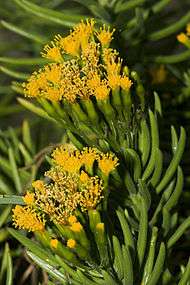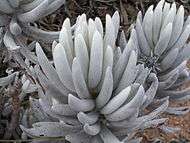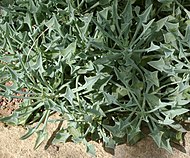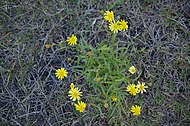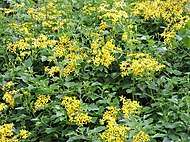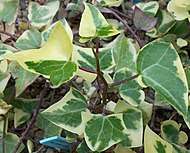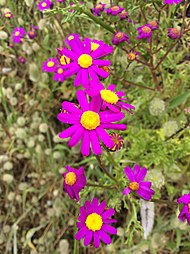Senecio
Senecio /sɪˈniːʃi.oʊ/[2] is a genus of the daisy family (Asteraceae) that includes ragworts and groundsels. The scientific Latin genus name, Senecio, means "old man."
| Senecio | |
|---|---|
 | |
| Senecio vulgaris, an illustration from 1885. | |
| Scientific classification | |
| Kingdom: | Plantae |
| Clade: | Tracheophytes |
| Clade: | Angiosperms |
| Clade: | Eudicots |
| Clade: | Asterids |
| Order: | Asterales |
| Family: | Asteraceae |
| Subfamily: | Asteroideae |
| Supertribe: | Senecionodae |
| Tribe: | Senecioneae |
| Subtribe: | Senecioninae |
| Genus: | Senecio L. |
| Type species | |
| Senecio vulgaris | |
| Species | |
|
Some 1,250; see text. | |
| Synonyms[1] | |
|
Dendrosenecio | |
Variously circumscribed taxonomically, the genus Senecio is one of the largest genera of flowering plants. The traditional circumscription of Senecio is artificial, being polyphyletic, even in its new circumscription which is based on genetic data.[3][4] Despite the separation of many species into other genera, the genus still contains c. 1,250 species and is one of the largest genera of flowering plants.[5] As no morphological synapomorphies are known to determine which species belong to the genus or not, no exact species number is known. The genus has an almost worldwide distribution[3] and evolved in the mid- to late Miocene.[6]
Some species produce natural biocides (especially alkaloids) to deter or even kill animals that would eat them.
Senecio species are used as food plants by the larvae of some Lepidoptera species — see list of Lepidoptera that feed on Senecio. Pyrrolizidine alkaloids have been found in Senecio nemorensis[7] and in Senecio cannabifolius var. integrilifolius.[8]
Morphology
The flower heads are normally rayed with the heads borne in branched clusters, and usually completely yellow, but green, purple, white and blue flowers are known as well.
In its current circumscription, the genus contains species that are annual or perennial herbs, shrubs, small trees, aquatics or climbers. The only species which are trees are the species formerly belonging to Robinsonia occurring on the Juan Fernández Islands.[9]
Distribution
The genus Senecio is distributed almost worldwide.[3] It is one of the few genera occurring in all five regions with a Mediterranean climate. Furthermore, species are found in mountainous regions, including tropical alpine-like areas.
Phylogeny
Many genera and the whole tribe are in need of revision. Many species currently placed in the genus need to be transferred to other or new genera, and others have been retransferred to Senecio. In its new delimitation the genus is still not monophyletic.[3]
Genera that have been included are the following:[3]
- Aetheolaena
- Culcitum
- Hasteola
- Iocenes B. Nord.
- Lasiocephalus Willd. ex Schltdl.
- Robinsonia
Synonyms
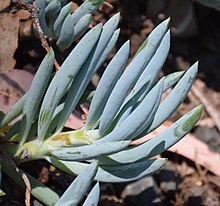
The following genera contain species that are or have been included within Senecio.[3]
- Antillanthus B. Nord.
- Barkleyanthus H. Rob. & Brettell
- Brachyglottis J. R. Forst. & G. Forst.[10]
- Canariothamnus B. Nord.
- Curio P.V. Heath
- Dauresia B. Nord. & Pelser
- Dendrophorbium C. Jeffrey
- Dendrosenecio (Hauman ex Hedberg) B. Nord. - Giant groundsels occurring in the high altitude areas of East Africa
- Dorobaea Cass.
- Dresslerothamnus H. Rob.
- Elekmania B. Nord.
- Herreranthus B. Nord.
- Hubertia Bory
- Jacobaea Mill.Leonis B. Nord.
- Ligularia
- Lundinia B. Nord.
- Mesogramma DC.
- Monticalia C. Jeffrey
- Nelsonianthus H. Rob. & Brettell
- Nesampelos B. Nord., nom. inval.
- Oldfeltia B. Nord. & Lundin
- Packera Á. Löve & D. Löve
- Pentacalia Cass.
- Pippenalia McVaugh
- Pittocaulon H. Rob. & Brettell
- Pojarkovia Askerova
- Psacaliopsis H. Rob. & Brettell
- Pseudogynoxys (Greenm.) Cabrera
- Pseudojacobaea (Hook. f.) R. Mathur
- Roldana La Llave
- Sinosenecio B. Nord.
- Synotis (C. B. Clarke) C. Jeffrey & Y. L. Chen
- Telanthophora H. Rob. & Brettell
- Tephroseris (Rchb.) Rchb.
- Vendredia Baill.[1]
- Zemisia B. Nord.[1]
Selected species
- Senecio ampullaceus — Texas ragwort, Texas squaw-weed, Texas groundsel, clasping-leaf groundsel[11]
- Senecio angulatus L.f. — creeping groundsel
- Senecio antisanae
- Senecio arborescens’'
- Senecio barbertonicus Klatt — succulent bush senecio
- Senecio battiscombei
- Dendrosenecio battiscombei
- Senecio bigelovii — nodding groundsel
- Senecio bosniacus G. Beck — Bosnian ragwort
- Senecio brasiliensis (Spreng.) Less. — flor-das-almas
- Cineraria brasiliensis
- Senecio candicans — angel wings
- Senecio cambrensis — Welsh groundsel, Welsh ragwort
- Senecio congestus (R. Br.) DC. — marsh ragwort, clustered marsh ragwort, marsh fleabane
- Cineraria palustris
- Othonna palustris
- Tephroseris palustris
- Senecio crassissimus
- Senecio douglasii — threadleaf groundsel
- Senecio elegans — purple groundsel
- Senecio crassissimus
- Senecio flaccidus Less. — Douglas senecio, threadleaf groundsel, threadleaf ragwort
- Senecio ficoides
- Curio ficoides
- Senecio gallicus Chaix — French groundsel
- Senecio glabellus Poir. — butterweed
- Packera glabella (Poir) C. Jeffrey
- Senecio glaucus L. — Jaffa groundsel
- Senecio haworthii — woolly senecio
- Senecio 'Hippogriff' — dolphin necklace, flying dolphins, dolphin plant
- Curio × peregrinus
- Senecio howeanus
- Senecio inaequidens — South African ragwort
- Senecio iscoensis — Hieron.
- Senecio jacobaea — is a synonym of Jacobaea vulgaris.
- Senecio keniensis
- Dendrosenecio keniensis
- Senecio keniodendron — giant groundsel
- Dendrosenecio keniodendron
- Senecio keniophytum
- Senecio kleinia
- Kleinia neriifolia
- Senecio kleiniiformis — spearhead
- Senecio lamarckianus
- Senecio leucanthemifolius Poir. — coastal ragwort
- Senecio littoralis
- Senecio madagascariensis — Madagascar ragwort
- Senecio macroglossus — Natal ivy, wax ivy
- Senecio mikanioides — Cape ivy, German ivy
- Delairea odorata
- Senecio nivalis Kunth
- Senecio obovatus Muhl. — roundleaf ragwort
- Packera obovata (Muhl. ex Willd.)
- Senecio patagonicus
- Senecio pauciradiatus
- Senecio pulcher
- Senecio radicans — string of bananas
- Curio radicans
- Senecio rowleyanus — string of pearls
- Curio rowleyanus
- Senecio sanmarcosensis
- Senecio scandens — German ivy[12][13]
- Senecio serpens — blue chalksticks
- Curio repens
- Senecio squalidus — Oxford ragwort
- Senecio trapezuntinus
- Senecio triangularis — arrowleaf groundsel
- Senecio vaginatus
- Senecio vernalis — eastern groundsel
- Senecio viscosus — sticky ragwort
- Senecio vulgaris — common groundsel, old-man-in-the-spring
Formerly in Senecio
- Brachyglottis greyi (as S. greyi)
- Florist's Cineraria, Pericallis × hybrida (as S. cruentus)
- Rugelia nudicaulis — Rugels ragwort
See also
References
- Germplasm Resources Information Network (GRIN) (2007-05-04). "Genus: Senecio L." Taxonomy for Plants. USDA, ARS, National Genetic Resources Program, National Germplasm Resources Laboratory, Beltsville, Maryland. Retrieved 2008-02-27.
- Sunset Western Garden Book, 1995:606–607
- Pelser, Pieter B.; Nordenstam, Bertil; Kadereit, Joachim W.; Watson, Linda E. (2007). "An ITS Phylogeny of Tribe Senecioneae (Asteraceae) and a New Delimitation of Senecio L". Taxon. 56 (4): 1077. doi:10.2307/25065905. JSTOR 25065905.
- Passalacqua, Nicodemo G.; Peruzzi, Lorenzo; Pellegrino, Giuseppe (August 2008). "A Biosystematic Study of the Jacobaea maritima Group (Asteraceae, Senecioneae) in the Central Mediterranean Area". Taxon. 57 (3): 893–906. doi:10.1002/tax.573018. JSTOR 27756716.
- Frodin, David G. (2004). "History and concepts of big plant genera". Taxon. 53 (3): 753–76. doi:10.2307/4135449. JSTOR 4135449.
- Pelser, Pieter B.; Kennedy, Aaron H.; Tepe, Eric J.; Shidler, Jacob B.; Nordenstam, Bertil; Kadereit, Joachim W.; Watson, Linda E. (2010-05-01). "Patterns and causes of incongruence between plastid and nuclear Senecioneae (Asteraceae) phylogenies". American Journal of Botany. 97 (5): 856–873. doi:10.3732/ajb.0900287. ISSN 0002-9122. PMID 21622451.
- Shi, Bao-Jun; Xiong, Ai-Zhen; Zheng, Shan-Song; Chou, Gui-Xin; Wang, Zheng-Tao (2010). "Two new pyrrolizidine alkaloids from Senecio nemorensis". Natural Product Research. 24 (20): 1897–901. doi:10.1080/14786419.2010.482058. PMID 21128163.
- Ma, H; Yang, L; Wang, C; Wang, Z (2011). "Pyrrolizidine alkaloids of Senecio cannabifolius var. Integrilifolius". Zhongguo Zhong Yao Za Zhi = Zhongguo Zhongyao Zazhi = China Journal of Chinese Materia Medica. 36 (2): 166–8. PMID 21506416.
- Pelser, Pieter B.; Tepe, Eric J.; Kennedy, Aaron H.; Watson, Linda E. (2013-06-10). "The fate of Robinsonia (Asteraceae): sunk in Senecio , but still monophyletic?". Phytotaxa. 5 (1): 31–46. doi:10.11646/phytotaxa.5.1.2. ISSN 1179-3163.
- Norton, D.A. (1986). "Recent changes in the names of New Zealand tree and shrub species" (PDF). New Zealand Journal of Forestry. 31: 39–40.
- Sean Claes (2007-04-16). "Proceed With Caution". Kyle, Texas Daily Photo. Retrieved 2008-04-10.
- Rines, George Edwin, ed. (1920). . Encyclopedia Americana.
-

External links
| Wikiversity has bloom time data for Senecio vulgaris on the Bloom Clock |
- Natural Resources Conservation Service (NRCS). "PLANTS Profile, Senecio L." The PLANTS Database. United States Department of Agriculture. Retrieved 2008-03-06.
- Germplasm Resources Information Network (GRIN) (2005-10-26). "Genus: Senecio L." Taxonomy for Plants. USDA, ARS, National Genetic Resources Program, National Germplasm Resources Laboratory, Beltsville, Maryland. Retrieved 2008-03-06.
- Germplasm Resources Information Network (GRIN) (2005-10-26). "GRIN Species Records of Senecio". Taxonomy for Plants. USDA, ARS, National Genetic Resources Program, National Germplasm Resources Laboratory, Beltsville, Maryland. Retrieved 2008-03-06.
- Integrated Taxonomic Information System Organization (ITIS) (20 December 2007). "Senecio L." Integrated Taxonomic Information System on-line database. Retrieved 2008-02-23.
- Botanic Garden & Botanical Museum Berlin-Dahlem. "Details for: Senecio". Euro+Med PlantBase. Freie Universität Berlin. Retrieved 2008-03-06.
- Missouri Botanical Garden (1753). "Seneco L." Tropicos Nomenclatural Data Base. Retrieved 2008-03-27.
- Royal Botanic Garden Edinburgh. "Flora Europaea Search Results". Retrieved 2008-03-06.
- Flora of Israel Online. "Search Results For 'senecio'". Hebrew University of Jerusalem. Retrieved 2008-03-06.
- Jerusalem Botanical Gardens. "LIST OF ALL PLANTS NAMES -WITH PHOTO S". Archived from the original on 2007-10-04. Retrieved 2008-03-06.
- Flora of North America. "Family List: 215. Senecio Linnaeus". 20: 540, 541, 542, 543, 544, 545, 570, 615. Retrieved 2008-03-06. Cite journal requires
|journal=(help) - Cyrille Chatelain; Laurent Gautier; Raoul Palese. "Senecio L." African Flowering Plants Database. Conservatoire et Jardin botaniques de la Ville de Genève. Retrieved 2008-03-06.
- Instituto Darwinion. "Asteraceae". Catálogo de las Plantas Vasculares de la República Argentina. II (in Spanish). Universidad de Buenos Aires. p. 255. Archived from the original (PDF) on August 21, 2007. Retrieved 2008-03-06.
- Helen Coleman, FloraBase: Flora of Western Australia (1997-06-18). "search term: Senecio". Flora Descriptions. Government of Western Australia. Retrieved 2008-03-06.
- Landcare Research. "Senecio L." Flora of New Zealand: Taxa. Landcare Research Allan Herbarium and New Zealand Plant Names Database. Retrieved 2008-04-01.
- "Search for:genus:Senecio". Species Information. Calflora — 1700 Shattuck Ave. #198, Berkeley, CA 94709. Retrieved 2008-02-09.
- Flora of Chile. "Volume 4 Asteraceae Senecio L". 4. Retrieved 2008-03-06. Cite journal requires
|journal=(help) - Richard Wunderlin or Bruce Hansen (2006). "Search Results For Search String: Senecio". Atlas of Florida Vascular Plants. Institute for Systematic Botany. Retrieved 2008-03-06.
- "Asteraceae". Primera página de la especie (in Spanish). Malezas de México. Retrieved 2008-03-06.
- PlantNET — The Plant Information Network System of Botanic Gardens Trust. "Search terms: Senecio". Botanic Gardens Trust. Retrieved 2008-03-06.
- University of Wisconsin–Stevens Point. "Senecio L." Robert W. Freckmann Herbarium. Retrieved 2008-03-06.
- Royal Horticultural Society. "RHS PLANT FINDER". Retrieved 2008-03-06.
- Manual of Gardening (Second Edition) at Project Gutenberg
